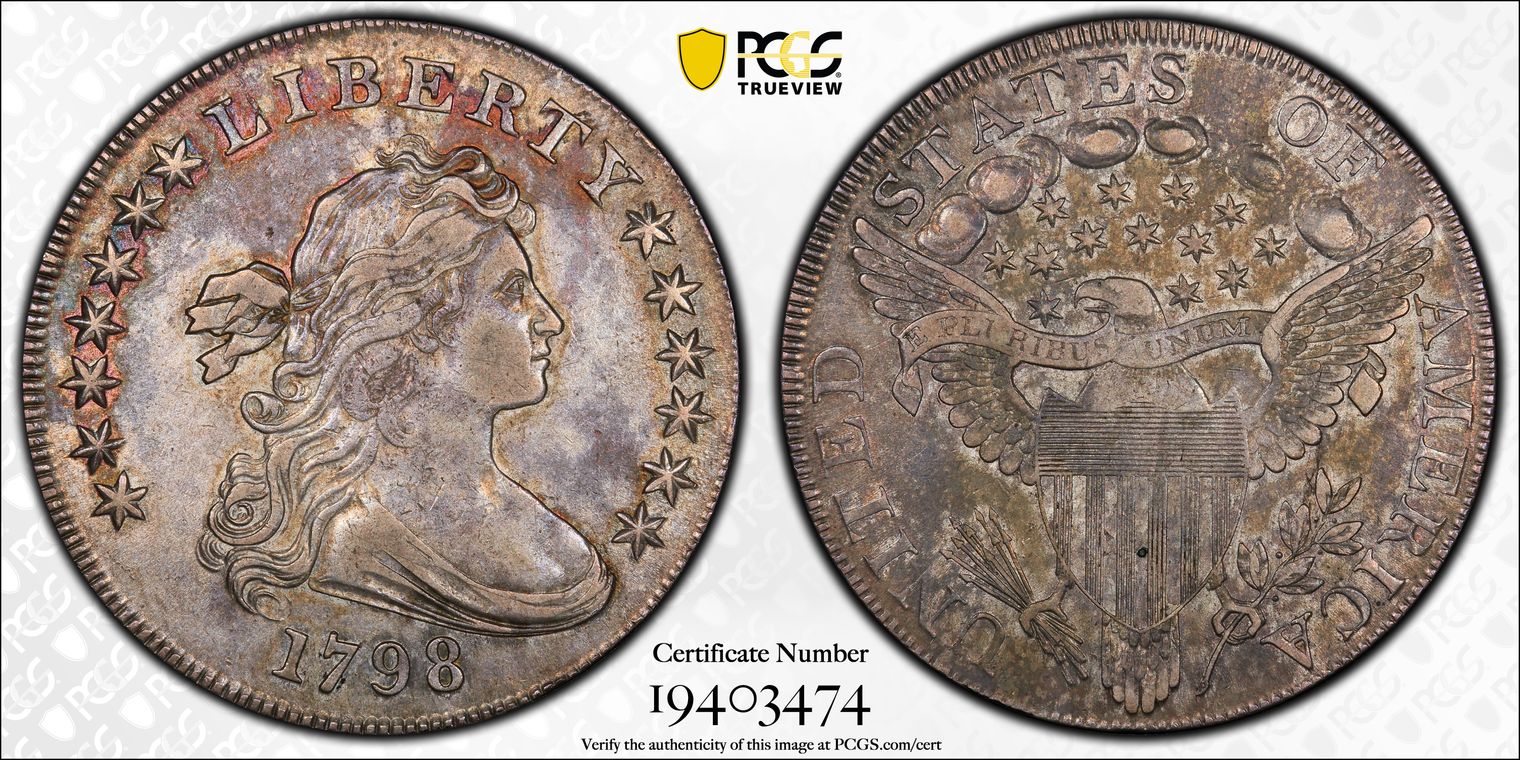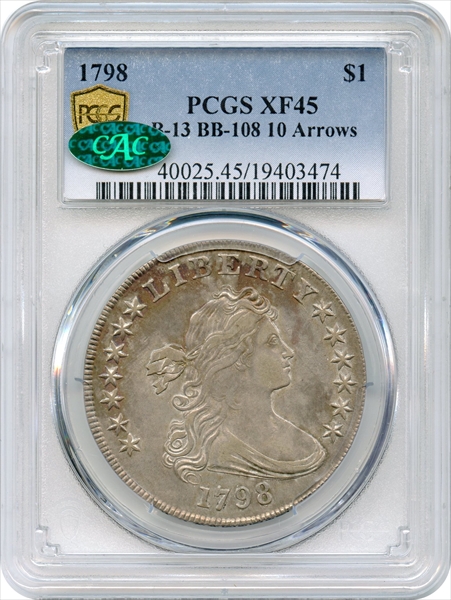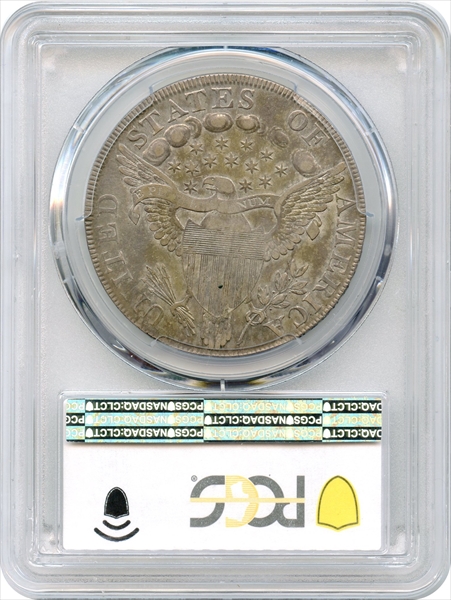1798 $1 BB-108 10 Arrows XF45 认证号19403474, PCGS号40025
拥有者评论
CAC. B-13, BB-108
专家评论
Q. David Bowers
The following narrative, with minor editing, is from my "Silver Dollars & Trade Dollars of the United States: A Complete Encyclopedia" (Wolfeboro, NH: Bowers and Merena Galleries, Inc., 1993). Note: the Notable Specimens list should be used with caution - it has been updated in my 2013 edition of "The Encyclopedia of United States Silver Dollars 1794-1804."B-13. H-13.
OBVERSE 9: Medium wide date, 10.5 mm. across at bottom widest place. Die crack upward from right portion of L in LIBERTY. Easily identifiable by a die flaw between ray of last star and bust. Among stars on the left, 1-2, 2-3, and 5-6 are more widely separated than other stars. On the right stars 8-9 are noticeably wider apart than are any others. A short crack, or flaw, extends into the field from a dentil opposite bust tip.
The use of this obverse die is especially interesting in that it was interrupted. This die was used first to strike examples of 1798 BB-108, then BB-109 dollars were struck, then additional BB-108 dollars were coined. Die state progressions provide the telltale evidence.
Obverse die used to strike BB-108 (early and late states) and 1798 BB-109 (intermediate state; 1798 BB-109, Die State III).
REVERSE I: Only 10 arrows. 5 small berries, 2 top ones closest together. Point of leaf under left lower tip of! in AMERICA. Star distant from eagle's beak. Arc star pattern. Die crack along right wing tip, top of AM to border above E. This is a later state of the reverse that used to have 10 arrows and a headless stick (used to coin 1798 BB-107). For the production of 1798 BB-108, the reverse die was relapped, removing the headless stick.
Reverse die used to strike 1798 BB-107 (earlier state) and BB-108 (later state, lightly relapped).
DIE STATES:
Die State I: Perfect obverse and reverse dies, not relapped. May not exist.
Die State II: Obverse crack toward border from right side of L in LIBERTY. Reverse with die relapped; headless stick no longer visible. With die crack along right wing tip, top of AM to border above E. The die state usually seen.
Die State III: Obverse now with crack from border below 17, left toward star 1. This is the die state used to coin 1798 BB-109. May not exist with BB-108.
Die State IV: Obverse now with crack from border below 17, left, now progressing through stars 1 to 5, very faint by star 5. About 20% to 30% of BB-108 dollars are of this die state.
COLLECTING NOTES: 1798 BB-108 is one of the commoner varieties of the year. I estimate that 500 to 800 survive, most of which are in grades through EF. However, AU coins come on the market with regularity. Mint State specimens are exceedingly rare.
NOTABLE SPECIMENS:
Willasch Specimen. MS-63.. Superior, H. Roland Willasch, 1990:487. Consigned by another individual to the Willasch Sale. "Frosty and intoned with no surface impairments the only mark readily visible is a minute planchet flaw above the N of UNITED on the reverse. Further scrutiny finds a tiny rim mark above the A of STATES. Boldly struck." Bebee's MS-60. Numismatist advertisement, May 1953. Brilliant Uncirculated.
Hollinbeck-Kagin Specimen. MS-60. Hollinbeck-Kagin Sale, January 1970: 782. Uncirculated bluish golden.
1976 ANA Specimen. AU-58. Stack's, 1976 ANA Convention Sale: 1332. Boyd, Brand and Ryder Collections, Bowers and Merena, 1990:2454. "AU-58. Satiny and largely brilliant with some blushes of pale champagne iridescence and splashes of faint blue toning. Close inspection reveals a faint, scarcely noticeable, hairline scratch on the reverse running across the eagle's shield and banner."
Boyd, Brand and Ryder Specimen. AU-58. - Bowers and Merena, Boyd, Brand, and Ryder Collections, 1990: 2453. "AU-58 to MS-60. A lovely, lustrous example displaying blushes of rich coppery golden and lilac coloration on both surfaces. Pleasing gunmetal-gray and electric blue iridescence enhance the extreme rims."
Gore and Long Specimen. AU-58. Bowers and Merena, Gore and Long Collections, 1990:357. "AU-58 to MS-60. Sharply struck with virtually all of Miss Liberty's hair details boldly delineated. Most of the eagle's feathers are sharp, including those along the top row of the breast. The fields are smooth and lustrous, toned in rich hues of lilac-gray, gun-metal-blue, and gold. A tiny lamination flaw can be seen at the reverse rim at 7:00, and is mentioned for accuracy although it doesn't measurable detract from the aesthetic appeal of the piece."
Kissel and Victoria Specimen. AU-58+. Bowers and Merena, Kissel and Victoria Collections, 1989:389. "AU-58/ MS-60. A pleasing, lustrous example faintly toned in pastel hues of gold, gray, lilac, and blue. Most of Miss Liberty's hair details are fully delineated, and nearly all of the eagle's wing and tail feathers can be seen, The eagle's breast is a bit softly defined overall, but even here the upper row of feathers is quite clear."
Blevins Specimen. AU-55. Superior, H.W. Blevins Collection, 1988:4763. "Late die state with all of the cracks described by Bolenderas well as numerous additional die flaws and areas of roughness on both the obverse and reverse. Very sharply struck and displaying ,a minimal, amount of wear but with irregular toning On both sides.". Yolanda Gross Collection.
Hirt and Bolt Specimen. AU-55. Pine Tree Auctions, Hirt and Bolt Collections, 1975:754. "Brilliant, frosty, with rich golden toning, this is at most a thin hair's breadth short of full Uncirculated. Obverse die flaw up to border from toe of L, others through base of Y and many stars on right."
PCGS #
40025
设计师
Robert Scot
边缘
Lettered: HUNDRED CENTS ONE DOLLAR OR UNIT
直径
40.00 毫米
重量
27.00 克
铸币数量
287536
金属成分
90% Silver, 10% Copper
更高评级数量
8
评级较低的钱币数量
15
地区
The United States of America
价格指南
PCGS 数量报告
拍卖 - PCGS 评级的
拍卖 - NGC 评级的


























